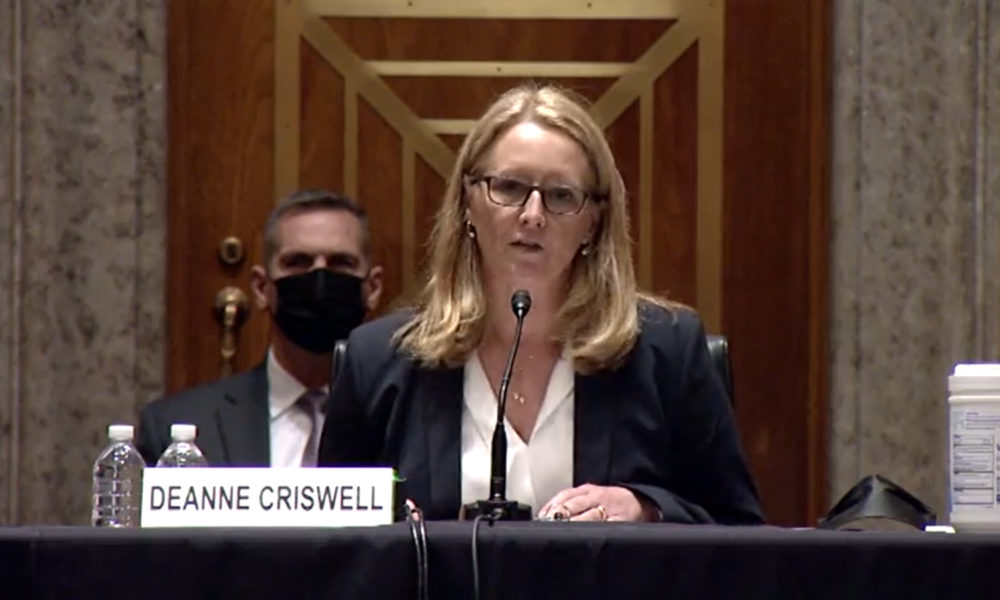Early in his presidency on January 15, President Biden nominated New York City’s Emergency Department Commissioner Deanne Criswell to be administrator of the Federal Emergency Management Agency (FEMA), signaling the importance of FEMA’s role in the COVID-19 pandemic, emergency management and climate change-fueled disaster relief. A few months later, the Senate Homeland Security and Government Affairs Committee (HSGAC) moved her nomination forward with a hearing where she testified in front of the committee and adeptly answered a range of different questions.
Then yesterday, on Earth Day, there was a lot to celebrate. The Biden administration announced its commitment to combat climate change and the Senate moved to confirm FEMA’s new administrator.
The Biden administration’s announcement of its goal for reducing US global warming emissions under the Paris Agreement by between 50 and 52 percent below 2005 levels by the end of this decade was the highlight for Earth Day 2021. As my colleague Rachel Cleetus stated “Our global climate commitments are tightly connected to our nation’s well-being and prosperity. When done right, US policies and investments to advance clean energy and climate resilience can bring tremendous benefits—including good-paying jobs, public health improvements, redress for environmental injustices, and funding for a fair transition for coal workers and communities.”
Perhaps the expedited move by the Senate to confirm, by unanimous consent, Deanne Criswell as the new FEMA administrator went under most people’s radars. However, this is another piece of news that we can celebrate.

Craig Fugate, former FEMA Administrator
Deanne Criswell has a long career in emergency management and has been well tested with stints at the Colorado Air National Guard working on firefighting; emergency and disaster planning for the City of Aurora, Colorado; leading incident command at FEMA under the Obama administration; and most recently working towards making people safe from COVID-19 and climate change fueled disasters for New York City’s emergency management department.
I jumped at the chance to ask former FEMA Administrator Craig Fugate, who served in the Obama administration, a few questions regarding Deanne Criswell’s strengths and the challenges she’ll face as FEMA addresses the ongoing COVID-19 pandemic; climate change fueled disasters; and the needs of historically disadvantaged, low-income and tribal communities. Here are Mr. Fugate’s answers to my questions and my additional commentary.
How significant is it that Deanne Criswell will be the first woman to lead FEMA since it was created in 1979?
Craig Fugate: Deanne is the first woman to be nominated to the position of FEMA administrator, Nancy Ward was the first woman to serve as acting FEMA administrator during the transition in 2009. I would hope people think of Deanne as an emergency manager and leader rather than just the first female FEMA administrator.
Shana Udvardy: It’s good to be reminded that there are many women in the leadership positions in the emergency management field and that Nancy Ward was one of the early leaders.
What will be Deanne Criswell’s biggest challenges in her new role as FEMA administrator given the ongoing COVID pandemic and increasing cost of disasters fueled by climate change?
CF: The management systems, including Information Technology (IT) and grants management, are very far behind in their updates and upgrades. Most people think the external issues are the biggest challenges, but these systems have major impacts on any administrator’s priorities.
SU: The government watchdog agency, the Governmental Accountability Office (GAO) made six major recommendations on how FEMA could improve their IT system. GAO also reported on the challenges embedded in four of FEMA’s state and local hazard mitigation grant programs, including that local and state officials found the grant process to be lengthy and complex. Hopefully Congress will appropriate the resources FEMA needs to meet both the IT and grant challenges with robust and timely solutions.
How do you anticipate Deanne Criswell integrating climate change into FEMA’s mission? What resources would help her do this and should Congress play a role in prescribing what that ought to look like (for example, the bill R. 744, the FEMA Climate Change Preparedness Act, would establish a subcommittee of FEMA’s National Advisory Council)?
CF: Climate adaptation will be a key focus for FEMA, how do we build for future risk, not just [the] history of risk. The Building Resilient Infrastructure and Communities (BRIC) 406 [Section 406 – Public Assistance Program] and 404 [Section 404 – Hazard Mitigation Grant Program] are sources of funding to build greater resilience in infrastructure. Another area that needs funding is the [National Flood Insurance Program] NFIP mapping, to include future climate risk.
SU: Emergency and floodplain managers celebrated the establishment of the BRIC program with the hope it would provide a new robust source of pre-disaster risk mitigation funding (I wrote about this in this blog post), and it seems BRIC is proving to be a well-resourced program supporting a variety of risk reduction projects across the nation but also with a welcome focus on small and impoverished communities, as well as tribal communities. Mr. Fugate also points to a critical need for Congress to support funding for FEMA’s efforts to include future climate risk in NFIP flood maps. Just recently, FEMA’s Technical Advisory Council (TMAC) released their long awaited 2020 Annual Report, which focuses on ways to establish a framework and incorporate best practices into a future flood hazard and flood risk identification program—underscoring Mr. Fugate’s recommendation. Hopefully, Deanne Criswell can make a successful case to Congress to fund future flood risk mapping and advance this critical (and overdue) work as quickly as possible.
Does FEMA need a dedicated office on climate change or would a subcommittee like what H.R. 744 would establish be sufficient?
CF: A new office would be a waste of time. Unless this is built into all of FEMA’s funding programs, it’s window dressing. Deanne can do it under direction from the [White House]. The Senate may have a hard time adding climate adaptation to any funding bills. But there has been bipartisan support for building resilience in infrastructure projects to future risk.
SU: The Union of Concerned Scientists (UCS) supports H.R. 744 however Mr. Fugate’s point still stands, climate change must be integrated throughout the agency, from top to bottom, and the intent of H.R. 744 is to do just that. In addition, Congress has a role to play in how it allocates funding to FEMA for this work. UCS agrees that we could see bipartisan support for such funding.
What role could Deanne Criswell play in moving Risk Rating 2.0 (RR 2.0) forward when we’re seeing a backlash by some members of Congress on flood insurance rate hikes? Additionally, what role can she play in ensuring Congress moves forward with establishing a flood insurance affordability program while also ensuring full risk rates?
CF: By focusing on the fairness issue of [Risk Rating 2.0], why should inland NFIP policyholders subsidize secondary homes (vacation) homes on the coast. And many of those inland policy holders are communities of color. Rates will be adjusted both up and down based on risk.
SU: Agreed. One could say that the elephant in the room is if and how Congress gives FEMA the authority to establish a flood insurance affordability program. Based on vast expert input, FEMA released a framework for how Congress could do just this. The NFIP comes up for reauthorization this September; it’s time for Congress to stop kicking the can down the road and make sure flood insurance is affordable for those low-income communities while also adequately reflecting actual flood risk.
In the recent HSGAC hearing Deanne Criswell said “We must reduce risk through system-based mitigation. We must increase the resilience of our communities so they can adapt as threats change.” What policies can she implement to ensure system-based risk mitigation, especially for historically disadvantaged, underserved, and low-income communities? Public input and analyses indicate that small and low-income communities either don’t qualify for disaster loans or don’t have the resources or technical expertise to apply for FEMA mitigation grants, for example under BRIC. Moreover, data show that “underlying vulnerabilities, often caused by structural racism and income inequality, impede recovery after disasters as much as the actual physical damages.”
CF: The resiliency divide has been growing. FEMA is already looking at how much weight should be placed on the cost-benefit of the project versus impacts to people. Deanne can build on this with a focus on impacts to people rather than just [using] the [cost benefit of investing in natural hazard mitigation which can save anywhere from $4 to $9 for every $1 spent on federal mitigation grants] to justify investments in mitigation funding.
SU: Absolutely! We know that more assistance and resources are needed to help low- and fixed-income, historically disadvantaged and tribal communities prepare and recover from disasters. The COVID-19 pandemic has exacerbated already trying conditions for these communities. At UCS, we look forward to supporting changes to these underlying policies that put such communities at even greater risk.
What changes could Deanne Criswell implement to do things like ensuring more technical assistance to these communities, ensuring that the grant submission process isn’t too cumbersome to apply for the assistance, etc.?
CF: Either funding states to add mitigation staff or providing more management cost to manage the application and project management of these grants. A concern is reduction in [an] oversight requirement could lead to more [Office of Inspector General] IG investigations. So how will FEMA balance oversight with simplifying the application process.
One thought is FEMA hiring a resiliency workforce, similar to other recommendations for staff to address climate change. This workforce could then be assigned to help develop and implement projects in small and low-income communities.
SU: Yes! FEMA would benefit from a robust expansion of technical assistance to people of color, tribal communities and communities that have been historically underserved, marginalized, and adversely affected by persistent poverty and inequality. On January 20 this year, President Biden released Executive Order 13985 “Advancing Racial Equity and Support for Underserved Communities Through the Federal Government” which Deanne Criswell will need to lean into. Based on her testimony (see Deanne Criswell’s answer to Senator Hassan’s questions at minute 00.53.00), I believe she will. Congress ought to enable FEMA to establish such a workforce with a targeted focus on the communities in need and those that have been hit repetitively by climate change fueled disasters.
As we move forward after celebrating the good news regarding the emission reduction goals and the confirmation of the new FEMA administrator on Earth Day this year, I think we all recognize that the real work lies ahead. It is encouraging that President Biden has committed to a whole-of-government approach to move our climate goals forward. Deanne Criswell is coming at an extremely challenging time with the COVID-19 pandemic, climate change and social justice crises at full steam. Administrator Criswell has a big job ahead of her and we look forward to working with her to ensure that FEMA is effectively helping communities to reduce their risks to be better prepared for climate change-fueled disasters and protecting communities from future risks.

